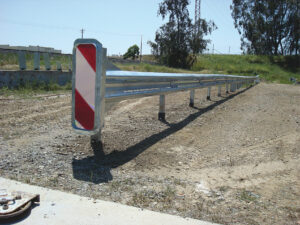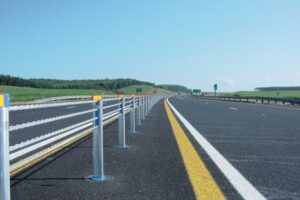The Building Blocks of a Good Guardrail System
Every road safety device offers specific benefits and serves a main purpose, along with one or more secondary functions. However, for the product to serve its purpose, its design must support the intention. To this end, there are several types of barriers used on South African roads. Some are more suited for high-speed travel paths than others, while others are more cost-effective to install. To determine the building blocks of a good guardrail system, you cannot separate the purpose for installation from the product. The right type of barrier must be installed at the right location. In addition, correct installation procedures must be followed.
To gain a better understanding of the buildings blocks that make up a good guardrail system, we will first look at some of the main types of road barriers and their characteristics.
Main functions of the guardrail system
A barrier serves one of three, or a combination of the three main functions. The first is to prevent something from breaking through or going over the barrier into a hazardous situation or collision with a hazardous object. The second is to redirect the vehicle back to its original path. The third is to absorb the kinetic impact energy and distribute it across the entire system, away from the vehicle and its occupants. In this case, it serves to reduce the impact of the collision on the vehicle and its occupants. That said, guardrails also serve several other functions, such as protecting the property or people behind the barriers from the impact or risk of impact from straying vehicles.
Other functions include, but are not limited to:
- Indicating the edge of the road, and thereby the end of the safe travel path.
- Separating lanes, whether permanently or temporarily.
- Demarcating an area for a specific purpose.
- Preventing pedestrians and animals from entering the vehicle travel path.
- Improving driver confidence as a barrier is in place to prevent accidental moving into a hazardous situation, such as going down a ravine, into a water source or colliding with a tree.
Understanding the many functions of the barrier, one can now look at the categories based on some of the performance characteristics of each.
Guardrail system to prevent breakthrough 
The more rigid the barrier is, the less likely that a vehicle can break through upon impact. This type of system is made to prevent breakthrough. An example is a concrete wall barrier that is installed in the median of two opposite flowing highways. A head-on collision with a concrete barrier will cause severe damage to the vehicle and high risk of excessive injury to the occupant. This is because the more rigid the barrier, the less kinetic energy absorption it has. It doesn’t distribute the energy away from the vehicle that collides with it. As such, the vehicle takes the larger part of the impact force. This doesn’t mean the barrier is inadequate. It serves the purpose of preventing breakthrough. With it being more rigid, it is also more permanent.
A W-beam guardrail system is rigid enough to stop breakthrough but has some energy absorption characteristics because the collision impact energy is absorbed and distributed across the entire system. In this sense it is also preventing breakthrough, but is more forgiving than a concrete wall.
A wire-rope system doesn’t have the same level of stopping power as the concrete barrier or the W-beam guardrail, but it takes up less surface space. It also absorbs more of the kinetic impact energy with less impact on the vehicle and its occupants. However, breakthrough can occur, making it essential to install a W-beam barrier on, for instance, a bridge rather than the wire-rope type. However, the wire-rope type can be installed where impact energy absorption is more important and where surface space is limited. It is also permanent.
Redirection capacity

Another function of the barrier is to redirect the vehicle to its original path, away from the danger. A concrete barrier, upon side-impact, reduces the speed of the vehicle due to friction. The design includes an angled section at the bottom. If the vehicle’s wheels hit this section, the vehicle is redirected into its original path due to the angle of the slope. It does have redirection capacity for side-angle impact due to its design.
The W-beam type has steel panels attached to posts. Upon side impact, the vehicle’s speed is reduced due to friction. The slight bump with panels can help to move the vehicle back into its original path. The inherent design of the barrier makes this possible.
The wire-rope fence has limited redirect capacity as it is more designed for absorption of the kinetic energy.
Energy absorption
Of all three, the wire-rope fence works best to minimise the collision impact on the vehicle and its occupants as it gives way the most, while distributing the force across the rope system. The concrete barrier absorbs almost no energy, with most of the force taken by the vehicle. The W-beam guardrail system gives way slightly, but absorbs a considerable level of impact force and distributes it across the entire system.
Given that all three types have advantages and disadvantages, the type to install depends on factors such as:
- Speed of travel.
- Whether to prevent breakthrough, redirect or to absorb energy.
- Clearance area available behind the barriers.
With these functions and characteristics in mind, let’s take a closer look at the building blocks for a good guardrail system:
- Durability – if the barrier is to be installed permanently, it must last for a long time. To this end, each component must be made to be corrosion resistant, able to handle impact, and remain functional regardless of weather conditions.
- Serve the main purpose well – the design must fit the reason for installation, whether to prevent breakthrough, protect against hazardous situations, to reduce impact force on the vehicle and its occupants, or to redirect the vehicle back to the safe travel path.
- Ease of installation and low cost of maintenance – if the barrier takes a long time to install, repair and maintain, it means more risk for the workers and road users. If a section is damaged, it must be removable to ensure only the particular section needs to be replaced. The cost of ownership must be kept low as well.
Where to find a guardrail that meets the purpose, durability, and maintenance requirements
Reach out to Armco Superlite for more information on the available guardrail systems, including the wire-rope fence and the W-beam guardrail, in addition to temporary barriers. Each product in the Armco Superlite product stable meets superior quality, safety, manufacturing and low cost of ownership requirements.

